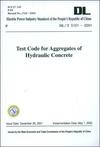DL/T 5151-2001 水工混凝土砂石骨料试验规程
出版时间:2009-2 出版社:中国电力出版社 作者:中华人民共和国国家经济贸易委员会发布 页数:102 字数:85000
前言
As one of the basic codes in the standard system of water resourcesand hydropower construction,the Test Code for Aggregates of Hydraulic Concrete is voluntary standard.The related contents in this Code are originated from SD 105一1982.Test Code for Hydraulic Concrete.According to the requirement of management of the electric power industry standards(Document No.40[1996]) issued by the former Ministry of Power Industry in 1996,the Test Code for Hydraulic Concrete SD 105-1982 was revised for the second time,to meet the need of the development of hydropower and water conservancy construction in China,and to coordinate with the development of standards of same categories at home and abroad.The original code was amended,supplemented and divided into Test Code for Hydraulic Concrete.Test Code for Aggregates of Hy draulic Concrete and Analytical Test Code for Water Quality of Hydraulic Concrete.The original Test Code for Hydraulic Concrete SD 105-1982 is replaced by the three newly published codes,with the original Chapter 3,"Aggregates"replaced by Test Code for Aggregates of Hydraulic Concrete DL/T 5151-2001.TestCodeforAggregatesofHydraulicConcreteDL/T5151——2001,including 34 test methods,gives prominence to the aggregate quality,especially the aggregate soundness required by hydraulic mass concrete.A lot of supplement was done for the alkali aggregate reactivity test methods.
内容概要
revised for the second time,to meet the need of the development of hydropower and water conservancy construction in China,and to coordinate with the development of standards of same categories at home and abroad.The original code was amended,supplemented and divided into Test Code for Hydraulic Concrete.Test Code for Aggregates of Hy draulic Concrete and Analytical Test Code for Water Quality of Hydraulic Concrete.The original Test Code for Hydraulic Concrete SD 105-1982 is replaced by the three newly published codes,with the original Chapter 3,“Aggregates"replaced by Test Code for Aggregates of Hydraulic Concrete DL/T 5151-2001.
书籍目录
Foreword1 Scope2 Normative Reference3 Fine Aggregates 3.1 Test for Grain Gradation of Sand 3.2 Test for Apparent Density and Water Absorptivity of Sand 3.3 Test for Apparent Density of Sand (Lee's Pycnometric Density Method) 3.4 Test for Water Content and Surface Water Content of Sand 3.5 Test for Surface Water Content of Sand 3.6 Test for Bulk Density and Porosity of Sand 3.7 Test for Clay, Silt and Clastic Matter Content of Sand 3.8 Test for Clod Content of Sand 3.9 Test for Organic Matter Content of Sand 3.10 Test for Mica Content of Sand 3.11 Test for Sulfate and Sulfide Contents of Sand and Stone Aggregates 3.12 Test for Light Matter Content of Sand 3.13 Test for Soundness of Sand4 Coarse Aggregates 4.1 Test for Grain Gradation of Cobble or Crushed Stone 4.2 Test for Apparent Density and Water Absorptivity of Cobble or Crushed Stone 4.3 Test for Surface Water Content Ratio of Cobble or Crushed Stone 4.4 Test for Bulk Density and Porosity of Cobble:0r Crushed Stone 4.5 Test for Mud Content of Cobble or Crushed Stone 4.6 Test for Clod Content of Cobble or Crushed Stone 4.7 Test for Organic Matter Content of Cobble 4.8 Test for Slender and Flaky Particle Content of Cobble or Crushed Stone 4.9 Test for Oversize and Undersize Particle Content of Cobble or Crushed Stone 4.10 Test for Soft Particle Content of Cobble 4.11 Test for Crushing Index of Cobble or Crushed Stone 4.12 Test for Compressive Strength and Softening Coefficient of Rock 4.13 Test for Soundness of Cobble or Crushed Stone 4.14 Test for Abrasion Resistance of Cobble or Crushed Stone5 Alkali Reactivity of Aggregates 5.1 Test for Alkali Reactivity of Aggregate (Petrographic Method) 5.2 Test for Alkali Reactivity of Aggregate (Chemical Method) 5.3 Test for Alkali Reactivity of Aggregate (Mortar Bar Length Method) 5.4 Test for Alkali Reactivity of Carbonate Aggregate 5.5 Test for Alkali Reactivity of Aggregate(Accelerated Mortar Bar Test Method) 5.6 Test for Alkali Reactivity of Aggregate (Concrete Prism Test Method) 5.7 Test for Alkali Reactivity Inhibition of Aggregate
章节摘录
5.1.1 Purpose and scopeTesting of alkali active aggregate categories and amount byidentifying the categories and the mineral components of the sand andstone aggregate with naked eyes or microscope.5.1.2 Apparatus1 Sieve:A set of sand sieves and a set of stone sieves,including circular hole sieves with aperture sizes of 150(120)mm,80mm,40mm,20mm,5mm and 2.5mm,square hole sieves withaperture sizes of 1.25mm,0.63mm,0.315mm,0.16mm,as well as thecover and the underpan;2 Pound scale:capacity 100kg,sensitivity 100g;3 Balance:capacity lkg.sensitivity 0.5g;4 Slicer,abrader and pointing machine;5 Stereo microscope and petrographic microscope;6 Corundum(No.150,No.400,No.600 and No.800),gum(such as fir gum),glass slide,microscopic glass,geologist'S hammer,chopping block,alcohol burner,etc..5.1.3 ProcedureI Sampling:1)Sample the stone materials by the quartering method,and sieve them after it is air-dried.Weigh out the requiredquantity of sample according to Table 5.1.3-1.
编辑推荐
《DL/T 5151-2001水工混凝土砂石骨料试验规程(英文版)》由中国电力出版社出版。
图书封面
评论、评分、阅读与下载
DL/T 5151-2001 水工混凝土砂石骨料试验规程 PDF格式下载
